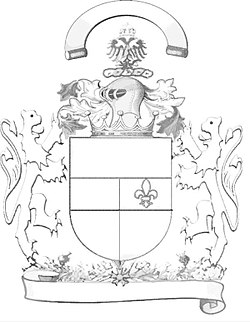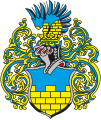Helmet cover
A helmet cover (also: lambrequin ) is the fabric part of the helmet that originally served as neck or head protection. In heraldry , the helmet covers were often an extension of the crest ornament .
The helmet covers also change with the different styles. The helmet cover, which was initially like a coat, was cut into strips (paddled) and fitted with tassels or fringes at the end. From the 16th century onwards , the helmet cover was only conceived as ornamental, i.e. with lots of flourishes.
As a rule - with exceptions - the colors of the helmet cover match those of the shield, with the metal mostly on the inside (lining) of the helmet cover and the color on the outside. An exception is, for example, the coat of arms of those of Bonstetten : "silver" (metal) outside, inside "black". In the description of the coat of arms, the outside is always mentioned first, then the inside. The helmet cover can also be "split", i. H. the ceiling tinging changes between right and left, which can result from the merging of several helmets with different helmet covers to one helmet, z. For example: "On black-gold-blue-silver puffed (see below) silver helmet with black and gold on the right and blue-silver covers on the left ...". Heraldically unusual, but occurring, is a horizontal division of the ceiling color, as can be seen on the middle helmet of the East Frisian coat of arms.
Often there is still the bulge on the helmet cover , a wreath woven from the colors of the helmet cover, often referred to as the Turk's League. In English heraldry , both the helmet and the helmet cover are omitted, only the bead is free-floating above the shield . If heraldic figures are placed on this bead, it becomes a crest and is used as a special form and restriction even without a heraldic shield .
Horn groschen from 1465 of the Freiberg mint , coat of arms with helmet covers
Helmet covers on the Roeder von Diersburg coat of arms (around 1450)
Helmet covers on the Bautzen coat of arms
Coat of arms of East Frisia with blue and red helmet covers
A special case is the development of the helmet cover from a central shield in the Hungarian coat of arms of Báránd .







